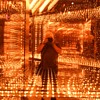Posted 11 years ago
 rniederman
rniederman
(346 items)
This is the largest early camera in my collection and, as you can see, it dwarfs a modern point-and-shoot digital camera. Imagine lugging this 35+ pound, 11 x 14 inch format behemoth around in the late 1850s! Making things more interesting, this is a wet collodion camera which means that photographers needed a portable darkroom ... usually a wagon ... filled with chemistry, glass plates and an assistant or two. This is because plates had to be prepared, pictures shot, and images developed before the chemistry dried out.
While not pristine by any means, I love the worn character of the camera with all its collodion chemical stains, marks and so forth. As a side note, I consider collodion stains a ‘badge of honor’ that this camera was heavily used in the field. While there is always a desire to get a clean camera, you would never refinish the wood for something like this.
The large 17" x 17" front and rear standards mounted on 25-inch folding rails must have made this a formidable camera in the field. Construction details point to a "box" (as cameras were called during this time) dating to the late 1850s to early 1860s.
Identifying early, unmarked cameras is always an adventure. Makers often borrowed ideas from each other, resulting in many cameras looking alike. It also makes life difficult for collectors (such as myself) who "need to know" about the lore and legacy of early equipment.
Clues to unmarked cameras are found in the smallest details. For example, the camera body is assembled with hand-cut dovetails instead of finger joints. While finger joint construction is typical for many other wet plate (post daguerreian) cameras, dovetails on American cameras made during this time are unusual.
Research attributes the builder to be Ebenezer Gordon (b.1817). Based on information obtained from a descendant cousin, Gordon entered into the photographic trade during its early years and was listed in New York directories as a plate maker (1847-1848), daguerreian frame maker (1851-1852), daguerreian supplier (1860) and photo materials salesperson (1869). Experience as a plate and frame maker probably gave Gordon a specialized insight into photographer's needs that led him to invent and patent an improved plate holder.
So be glad there are small, pocketable cameras and smartphones for most of your photographic needs!























stunning:)
The little point & shoot really shows how large this camera really is!
Nice write up as well.
David
Thanks, David and officialfuel!
Thanks, mtg75!
Thanks, Sean!
Thanks, Eric!
Thanks, walksoftly!
Thanks, DrFluffy!
Thanks, Bootson!
Thanks, Phil!
So how could they afford to take others with them to do all this extra work while pictures were being taken Rob? Not doubting you, just wondering how a man pays the help here.LOL
Hey Perry ... thanks! If I understand your question, you're asking about profitability. It depends on the photographer. If it was a business, they often had wagons and would stay at a location for a long time to generate lots of business. Before coming into a town, photographers hung broadsides (advertising posters) to drum up interest. I have an original daguerrian broadside and will post it sometime in the future. Some photographers, such as the very famous William Henry Jackson, had several assistants. From 1870 to 1878, Jackson was the official photographer for the United States Geological and Geographical Survey of the Territories. His work was one of the major factors in the congressional vote that established Yellowstone National Park in 1872. However not everyone was that good, but you get the idea. As always, thanks for stopping by!
Well that does make a lot more sense. Stay several days and make as much money as possible. I think many of us, including me didn't realize that this was the way they did business back then. Thanks Rob
Great question and answer, thanks gents!
Ben
Thanks, kerry10456!
Thanks, petey!
Thanks, Scott!
Thanks, DrFluffy!
Thanks again, Sean!
your very welcome Rob:)
Thanks, austrohungaro!
Thanks, catteann!
Thanks for linking this one for me rob.
Question about focus and image sizing. Was it a practical practice to use this type camera for ONLY large images-- say Mammoth/ whole plate?
Did photographers purchase multiple lenses to make large variations in sizes?
Just wondering as it would seem that as the images became smaller the image area would shrink as well.
For example, with my Mammoth plate ambrotype-- use of the SAME camera with SAME settings would yield only one person (in the family grouping) on a SIXTH plate.
I would appreciate a quick "lesson" if you have the time and inclination!
Thanks.
scott
Scott ... I thought of various ways to answer your questions but there’s no getting around it, this is a topic with a lot of nuances. Anyhow, cameras were made for specific needs.
The camera that made your mammoth ambro was (IMO) probably something 11 x 14 or larger with a reducing mask at the rear of the camera body. A lens that would project a 'normal' image for that format would have been used. However, the photographer could use a 10x12 lens to make the image. The reducing mask would cover only that area of the image circle needed for the picture and the plate holder could be modified to hold the matching sized plate. But let’s put the economics of big vs. small lenses aside for this explanation.
A Dallmeyer 5D portrait lens is a good example. Although made to cover at least 12x10, it projects an image circle that accommodates 15x12. This gave the photographer room to make minor shifts to fine-tune a composition. Even if the photographer used a smaller Dallmeyer 4D (or similar ... 10x8 covering 12x10), the back focus (not focal length) is about 13 inches and up to 16 inches for the 5D. That means the camera that made your ambro was not only large and robust to carry the weight of a bigger lens and plates, it also had very long rails to draw out the bellows to cover back focus. Multiple lenses on this large of a camera are not useful because (for example) the back focus of a 1-9 tube gem lens is typically 2-1/2 inches or shorter. Then again, a large camera that could have shot your ambro couldn’t physically focus to that short a distance even if for 1/6-plate.
It is possible to outfit a mammoth camera to make multiple images on a plate but there would be a physical restriction the size of the smallest lens. For instance, I have 5x7 inch wet plate cameras with 4-up tube sets that cannot handle a 9-up set. The lens board is large enough. The problem is that the camera cannot physically focus such a small gem lens. But with proper masks, 1/6-plate images can be made with the larger 1-4 tubes.
In summary, it is possible to make a 1/6-image on a mammoth camera only if larger lenses were used and masks placed over the plate. But the market didn’t see that as a good idea. For this reason, nearly all multiplying cameras were made no larger than 8x10 inch format. And in looking over my catalogues, I don’t have listings for multiple lens cameras larger than 8x10. Using Anthony as an example, in the early 1870s they sold an 8x10 “Imperial and Card Camera” and “Gem Multiplying Box”. Either could shoot anything from a single 8x10 image (large lens) up to 72 images on a 7x10 portion of the plate using tiny 1-9 gem tubes. The camera had a shifting back in combination with multiple lenses and masks to make more than nine images on a plate.
Also note that multi-lens cameras had to be built with rigid rails (normally used in a studio setting) as opposed to folding rails for portability. Yet some itinerant photographers traveled rigid rail cameras and set up make-shift studios in the field. Rigid rails are needed when using 4 or more lenses because of the precision needed to keep everything in focus. A folding (portable) camera such as my 11x14 Gordon posted here would not work well with four or more lenses ... actually; it would be an awful experience because no matter how you built a folding rail camera, it didn’t have the precision needed for multiple lenses.
Different lens sets could be used on Anthony's cameras (American Optical did the same thing). Small lenses with short focal lengths were needed ... the smaller the lens, the smaller the image and the higher number of pictures on a single plate. A photographer could buy a single body and outfit it with several different lens sets. (My 5x7 Peck style wet plate camera has 4-up and 9-up lens sets.) These are most common sets, and varying focal lengths depending on the size of the image could be purchased. For example, a photographer could buy a 4-tube set to cover an 8x10 plate. Then again, different 4-tube sets could be purchased for ¼-plate, 4x5, 5x7 and whole-plate camera formats.
Your last question asked if the camera that took the ambro could take a picture using the same camera with the same settings to yield only one person on a 1/6-plate (paraphrased). In theory, it could be done by masking the image and plate. But in reality photographers had different cameras for different types of work and the likelihood of the camera that shot the mammoth ambro would not be set up for 1/6-plate images.
Refer to my multi-lens camera post here: http://www.collectorsweekly.com/stories/91814-early-multiple-lens-wood-and-brass-field-c
Specifically, there are two cameras with different size 4-up lens sets. The Scovill 4-tube camera on the left does not have a shifting back and therefore is limited to what it can produce on a 5x7 plate. The 4-tube camera on the right is an Anthony Climax Multiplying camera with a shifting back. Notice that the lenses are smaller. They have a shorter focal length and produce smaller images. Yet masks could be put into the cameras to make four 1/6-plate images with the existing lenses.
GREAT INFORMATION Rob!
I appreciate you taking the time to answer my question. It is not something that I thought about prior to purchasing this mammoth plate.
So the photographer who took this image had the $$ to purchase a larger camera (Bigger, city studio) to take this type of image along with a smaller camera to take the "bread and butter" sixth plates that everyone wanted and could afford.
scott
That would be my guess. Unfortunately, inventories are quite rare and I've never had access to any original studio lists. But if you think about it, a larger operation wouldn't rely on a single camera in case something happened. Let me put some numbers to 1870s equipment to now look at economic reality:
* 10x12 Anthony Success View Camera with single swing: $44.00
* Dallmeyer 4D lens for camera: $121.50
(cabinet portrait distance optimized at 25')
* 8x10 Anthony Gem Box w/4-up AND 9-up lenses: $105.00
Whole and half-plate cameras were much less expensive.
As you can see, a multi-lens camera is very affordable in comparison to the larger equipment for mammoth images; and especially cost effective because you get lots of pictures from one taking (tintypes need to be snipped apart but glass plates could print many images that are cut apart).
Thanks, Manikin!
Thanks, aghcollect!
Thanks, whitman75!